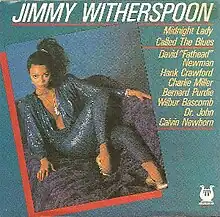| Midnight Lady Called the Blues | ||||
|---|---|---|---|---|
 | ||||
| Studio album by | ||||
| Released | 1986 | |||
| Label | Muse[1] | |||
| Producer | Doc Pomus, Dr. John | |||
| Jimmy Witherspoon chronology | ||||
| ||||
Midnight Lady Called the Blues is an album by the American musician Jimmy Witherspoon, released in 1986.[2][3] It was recorded shortly after Witherspoon recovered from throat cancer.[4] Midnight Lady Called the Blues was dedicated to Big Joe Turner.[5]
The album was nominated for a Grammy Award, in the "Best Jazz Vocal Performance, Male" category.[6]
Production
The album was cowritten and coproduced by Doc Pomus and Dr. John; it was allegedly recorded in eight hours.[7][8][9] It was the first time that Witherspoon had songs written explicitly for him.[10] Hank Crawford played saxophone on the album.[9] Bernard Purdie played drums.[11]
Critical reception
| Review scores | |
|---|---|
| Source | Rating |
| AllMusic | |
| The Encyclopedia of Popular Music | |
| MusicHound Blues: The Essential Album Guide | |
The Miami Herald determined that, "while Witherspoon is responsible for the blues vibrations in the studio, every musician shines in support."[9] The Washington Post called Midnight Lady Sings the Blues "one of the grittiest R&B albums he's ever made."[11] Cash Box deemed it "a saucy, creamy, steamy LP."[15]
AllMusic wrote that "the spirited set has more than its share of interesting and exciting moments despite the obscurity of the material."[12] The Guardian noted that the album "gave [Witherspoon's] admirers almost unalloyed satisfaction, thanks partly to sympathetic collaborators, but chiefly to his sheer professionalism."[16] MusicHound Blues: The Essential Album Guide dismissed it as "bland, uninspired."[14]
Track listing
| No. | Title | Length |
|---|---|---|
| 1. | "New York Blues" | |
| 2. | "The Barber" | |
| 3. | "Blinded by Love" | |
| 4. | "Happy Hard Times" | |
| 5. | "Something Rotten in East St. Louis" | |
| 6. | "Midnight Lady Called the Blues" | |
| 7. | "Blues Hall of Fame" |
References
- ↑ Popoff, Martin (September 8, 2009). "Goldmine Record Album Price Guide". Penguin – via Google Books.
- ↑ Deffaa, Chip (September 21, 1996). "Blue Rhythms: Six Lives in Rhythm and Blues". University of Illinois Press – via Google Books.
- ↑ Palmer, Robert (25 July 1986). "DOC POMUS STILL WRITES, ROCKS AND RAMBLES". The New York Times. p. C23.
- ↑ Morris, Chris (Oct 4, 1997). "Blues great Jimmy Witherspoon dies". Billboard. 109 (40): 15.
- ↑ "On The Record". News. United Press International. August 1, 1986.
- ↑ "Jimmy Witherspoon". Recording Academy. Retrieved 21 September 2022.
- ↑ O'Brien, Glenn (Dec 1986). "Spins". Spin. 2 (9): 35.
- ↑ Friedman, Josh Alan (September 21, 2008). "Tell the Truth Until They Bleed: Coming Clean in the Dirty World of Blues and Rock 'n' Roll". Hal Leonard Corporation – via Google Books.
- 1 2 3 Moon, Tom (August 22, 1986). "BLUESMAN'S LIFE SHAPES HIS SONGS". Miami Herald. p. 1D.
- ↑ Simon, Larry (July 29, 2021). "New York City Blues: Postwar Portraits from Harlem to the Village and Beyond". Univ. Press of Mississippi – via Google Books.
- 1 2 Joyce, Mike (August 15, 1986). "Witherspoon's Gritty Truths". The Washington Post.
- 1 2 "Jimmy Witherspoon - Midnight Lady Called the Blues Album Reviews, Songs & More | AllMusic" – via www.allmusic.com.
- ↑ Larkin, Colin (2006). The Encyclopedia of Popular Music. Vol. 8. MUZE. p. 743.
- 1 2 MusicHound Blues: The Essential Album Guide. Visible Ink Press. 1998. p. 411.
- ↑ "Feature Picks". Cash Box: 20. August 20, 1986.
- ↑ Russell, Tony (24 Sep 1997). "Obituary: Jimmy Witherspoon: Shout it out loud". The Guardian Features Page. The Guardian. pp. 1, 17.